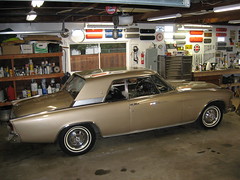Let's see if I can post this with out getting bashed about searching past post. (which I have done).
I have a 60 Hawk with a 289, automatic trans, that has developed a knock.[xx(] It does not knock when cold, has great oil pressure but when it warms up the oil pressure drops to a point that it scares me around 10-15 at 2000 rpm. A long time friend tells me it is most likely a rod bearing.
So out comes the shop manual, I believe this can be done in the car. I am going to pull each plug wire while it is running to narrow down the search. I will replace both bearings on the journal that has the bad rod bearing.
Now for my questions, what is the best way to replace the rear seal?
Does any one have a gasket list? or any advise on this process[?]
I am going to buy all the parts at York this year.
I have done a couple of brand X newer motor rebuilds but nothing this old. I have no knowledge of the engines prior life other than it has sat for 20 years prior to me flushing the engine, changing the oil after every run of 30 min. The knock is bad when giving the gas or letting off, Does it sound like a rod bearing to you guys?
I want to keep the stude motor even though my uncles have a ton of old chXXy motors they are pushing me to put in the old girl.
ANY help or thoughts would be Appreciated.
Thanks Rodney Tucker
Rodney
60 Black Hawk
On the road Again
I have a 60 Hawk with a 289, automatic trans, that has developed a knock.[xx(] It does not knock when cold, has great oil pressure but when it warms up the oil pressure drops to a point that it scares me around 10-15 at 2000 rpm. A long time friend tells me it is most likely a rod bearing.
So out comes the shop manual, I believe this can be done in the car. I am going to pull each plug wire while it is running to narrow down the search. I will replace both bearings on the journal that has the bad rod bearing.
Now for my questions, what is the best way to replace the rear seal?
Does any one have a gasket list? or any advise on this process[?]
I am going to buy all the parts at York this year.
I have done a couple of brand X newer motor rebuilds but nothing this old. I have no knowledge of the engines prior life other than it has sat for 20 years prior to me flushing the engine, changing the oil after every run of 30 min. The knock is bad when giving the gas or letting off, Does it sound like a rod bearing to you guys?
I want to keep the stude motor even though my uncles have a ton of old chXXy motors they are pushing me to put in the old girl.
ANY help or thoughts would be Appreciated.
Thanks Rodney Tucker
Rodney
60 Black Hawk
On the road Again

 In retrospect, I wish I'd taken the whole mess off his hands!
In retrospect, I wish I'd taken the whole mess off his hands!

 I am going to do all rod bearings and mains while I have the pan off as well as the front and rear seals, She does leak a little oil. Heres a pic
I am going to do all rod bearings and mains while I have the pan off as well as the front and rear seals, She does leak a little oil. Heres a pic

 ]
]
Comment